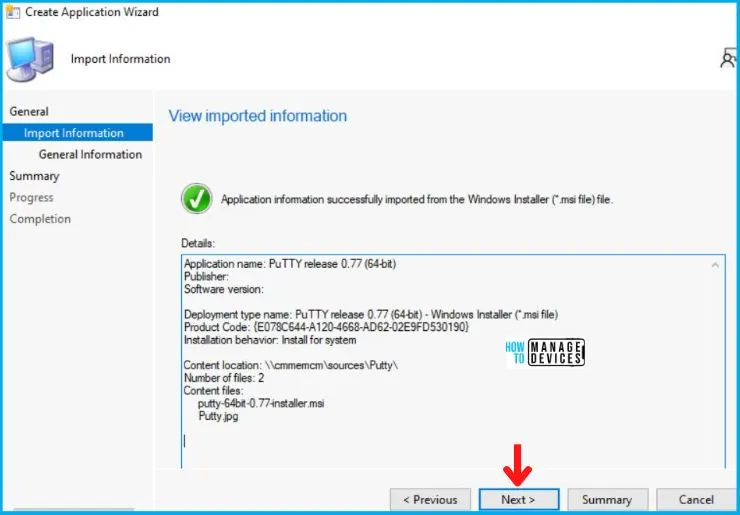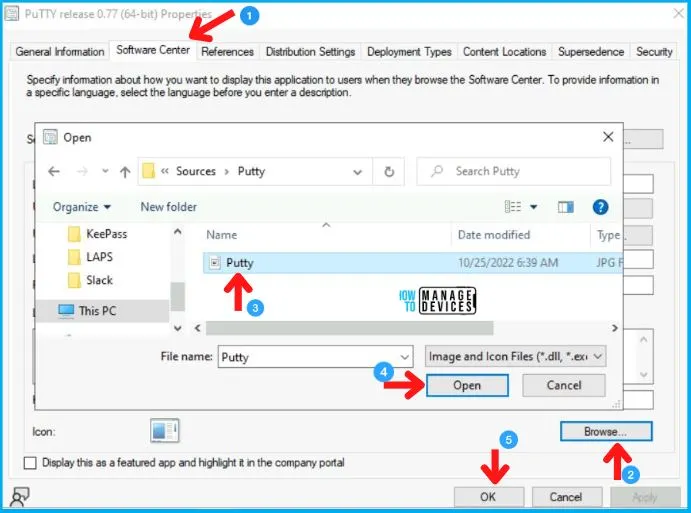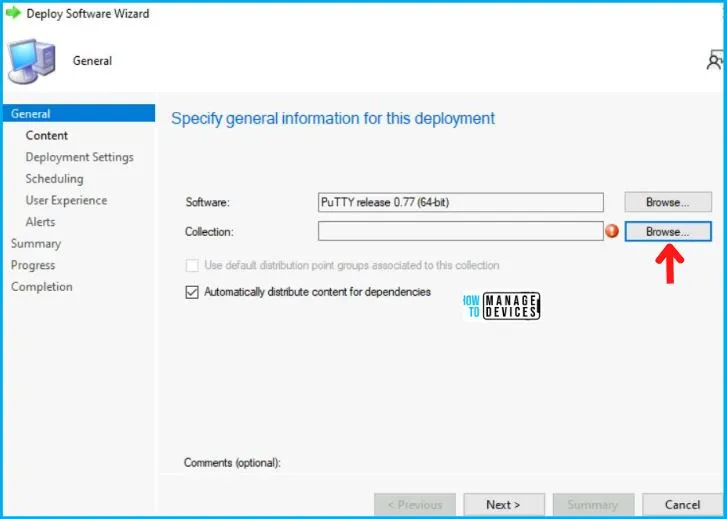Hey Everyone!! Here is another deployment post for you. In this post, we will see PuTTY Installation Using SCCM Application Model. In this detailed guide for Putty Deployment on clients’ machines, we will be using the MSI application.
PuTTY is Open-source software recommended to use for SSH connections from a Windows operating system. PuTTY allows you to access your files and email stored on the engineering servers. It is a free implementation of SSH (and telnet) for PCs running Windows.
PuTTY is a terminal emulator application that can act as a client for the SSH, Telnet, login, and raw TCP computing protocols. A PPK file (protected by Message Authentication Code) is used by PuTTY as a key file format.
AES, 3DES, RC4, Blowfish, DES, and public-key authentication are just some of the variations on the secure remote terminal supported by PuTTY. It also provides the user with the option of choosing their own encryption key and protocol version.
The MSI application is the best method to deploy the Putty to Windows 10/11 devices. In this Step-by-Step guide for Putty Application Deployment using SCCM, we will use the MSI file for the deployment.
PuTTY Install Uninstall Command Options
Let’s start with the Deployment of PuTTY using SCCM. As told earlier, we are using the MSI file for PuTTY Deployment. You will see why the availability of MSI files for any application brings sparkles in the eyes of the SCCM Admin.
Here we don’t need to work on prerequisites as we used to tell you in the previous posts in which we used EXE files.
- All we have to do is download the MSI installer and the logo of PuTTy, as we know it is available for download, and our half job is done.
One can easily download the latest Installer directly from Putty official site. They have provided different setups for different environments. One can easily differentiate and choose the right setup for Windows.
The following table gives you all the details required for the Puty Deployment tool using SCCM. This includes the command line for Putty silent install, Uninstall, and Product Code.
| Name | Install Command Line | Uninstall Command Line | Detection Method |
|---|---|---|---|
| Putty Deployment Tool – Windows Installer (*.msi file) | Install -> msiexec /i “putty-64bit-0.77-installer.msi” | Uninstall -> msiexec /x {E078C644-A120-4668-AD62-02E9FD530190} /q | Windows Installer – {E078C644-A120-4668-AD62-02E9FD530190} |
- Dell SupportAssist Deployment Using SCCM | MSI Installation Guide
- Deploy KeePass using SCCM | Step-By-Step Guide
PuTTY Application Creation Using SCCM Console
This MSI application deployment guide will use the SCCM admin console to create an application. To start with the Application creation part, copy the downloaded setup to the package source location of the SCCM Server.
- Navigate to SCCM Console\Software Library\Overview\Application Management\ Applications.
- Right-click on Applications and select Create Application.

For all MSI application deployments, always Select the Automatically detect Information about the application from installation files and choose Windows Installer (.msi files) in the Type category. Also, enter the UNC Path for the application in Location and click Next as shown below in the image.

Now you will see the real Magic!!! As soon you click on next, you will see that all the information has been imported from the MSI file as shown below, and click Next.

Also in the General Information Tab shown below, you will see it imports the install behavior/command (msiexec /i “putty-64bit-0.77-installer.msi” /q) from the installer itself.
- Silent Command Line for Putty = msiexec /i “putty-64bit-0.77-installer.msi” /q

After this, click Next on the Summary Tab and end this Create Application Wizard by clicking on Close in Completion Tab.

After the creation of the Application, it will appear in the Application Node. Now to Add an Icon to the Putty, right-click on the Puty and click on Properties.
After this choose Software Center Tab as shown below. And click on Browse in Icon, select the icon, and click on Apply and OK, as shown in the image below.

Distribute Putty Application to the DP
After the creation of the Application, it will appear in the Application Node. To begin with, the distribution right-clicks on the Putty Application and clicks on Distribute Content, as shown in the picture below.

Now the Distribute Content Wizard will open, and click Next in the General Tab. Then select the Application Name in the Content Tab and Click on Next, as shown in the image below.

After this, in the Content Destination Tab, Click on Add and select the Distribution Point option.

Then Add Distribution Point page will pop up, choose the Distribution Point on which you want to distribute the Application and click on OK, and then on Next.

After this, Click Next on Summary Tab and complete this Distribution process by clicking Close on Completion Tab.

Deploy PuTTY using SCCM
So as of now, we have accomplished two tasks i.e., Application Creation and Application Distribution to the DP. Now all that is left is the Deployment of the Putty on the All Windows 10 Device Collection.
- As you can see, your Application is displaying in Application Node, Right-click on Putty and select Deploy.

After this, Deploy Software Wizard opens, and in the General Tab, enter the Name of the Application and click on Browse to select the Collection.

Now the Select Collection page will pop up; choose Device Collection from the drop-down menu, and then
- Select your targeted Device Collection and click on OK, and then Next.
- Here I choose All Windows 10 Devices.

Now in the Deployment Settings Tab, select:
- Install in the Action box
- And choose Available in the Purpose category.

In the Scheduling Tab, enter the time details if you want it to be available at a specific time; otherwise, leave it as it is and click Next. After this, in the User Experience Tab,
- Select Display in Software Center and shows all notification options in the User
- Select Display in Software Center and shows all notification options in the User notifications, and click on Next as shown below.

In the Alerts and Summary Tab, click on Next and to end the process, click on Close in the Completion Tab.

- Insiders Guide SCCM Application Model Troubleshooting
- Deep Dive SCCM Application Model Troubleshooting – Client End
End User Experience – PuTTY Deployment
In this section, we will check the end-user experience for Putty Application Deployment and Installation. The PuTTY Application is Created, Distributed, and Deployed.
Now, if you check the Software Center of Win 10 device from the Windows 10 Device (or All Windows 11 Device) Collection, you will see the Application in Available Mode, and the user can install it as per the requirement.

As you can see in the below screenshot, the Putty Application is installed successfully on Windows 10/11 devices. This proves that the above MSI installer works fine for Putty Application Installation using SCCM.

So the above picture depicts that we have finally created, Distributed, Deployed, and Installed the Putty Application shown in the Software Center as shown in the above image.
Author
Abhinav Rana is working as an SCCM Admin. He loves to help the community by sharing his knowledge. He is a BTech graduate in Information Technology.

Thank you. I appreciate the guide. I found this guide while researching a problem I’m experiencing packaging & deploying PuTTY 0.78. Your guide was identical to my packaging process, so it was good to have confirmation I’m not doing anything grossly wrong. The only difference is that I’m deploying PuTTY as Required, not Available. The issue I’m experiencing is that PuTTY is not creating the application shortcuts in the Start Menu, and is not showing up in Add or Remove Programs, though the executable files are created in “C:Program FilesPutty” and it will start from Putty.exe.
G’day Claude,
By default, the Putty installer adds the shortcuts to
C:\Users\\AppData\Roaming\Microsoft\Windows\Start Menu\Programs\PuTTY (64-bit)
where is the name of the user who installed the software (ie an account with admin privileges), so only that acocunt sees the shortcuts.
When SCCM runs using a service account, there is no roaming appdata folder to install the shortcuts in, so that bit fails.
If you add the parameter ALLUSERS=1 to the msiexec command, it installs the shortcuts into
C:\ProgramData\Microsoft\Windows\Start Menu\Programs\PuTTY (64-bit)
instead, so all users on the computer have access to the shortcuts in their start menu.
I’ll try that again, this time with HTML codes for angle brackets 🙂
G’day Claude,
By default, the Putty installer adds the shortcuts to
C:\Users\<username>\AppData\Roaming\Microsoft\Windows\Start Menu\Programs\PuTTY (64-bit)
where <username> is the name of the user who installed the software (ie an account with admin privileges), so only that acocunt sees the shortcuts.
When SCCM runs using a service account, there is no roaming appdata folder to install the shortcuts in, so that bit fails.
If you add the parameter ALLUSERS=1 to the msiexec command, it installs the shortcuts into
C:\ProgramData\Microsoft\Windows\Start Menu\Programs\PuTTY (64-bit)
instead, so all users on the computer have access to the shortcuts in their start menu.